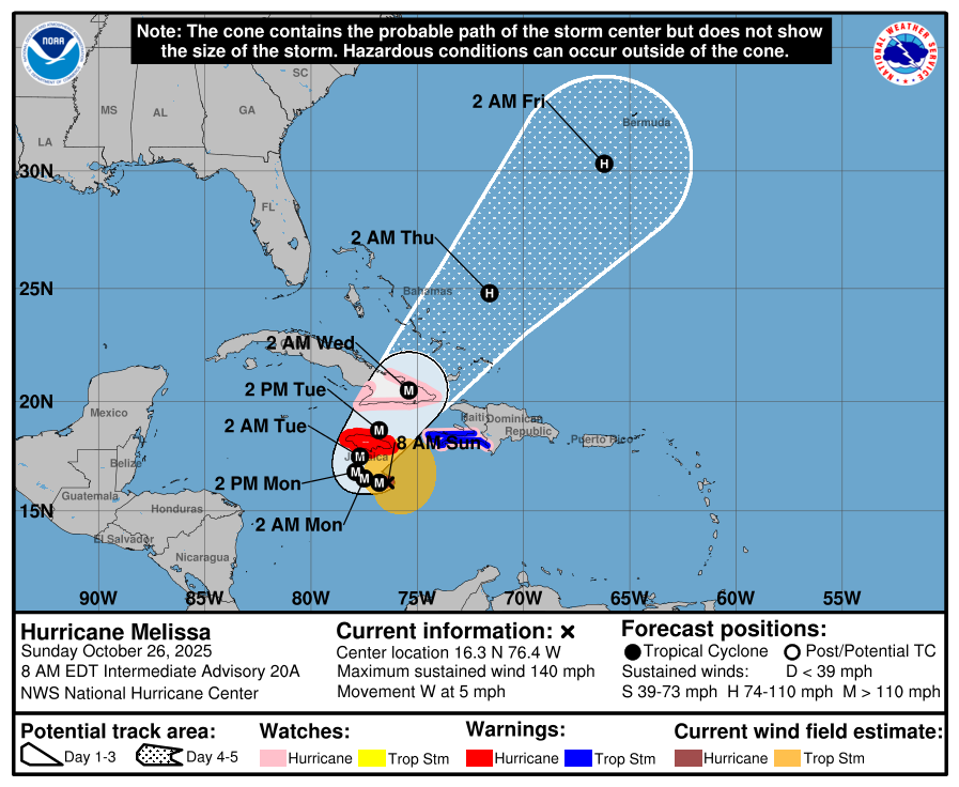Hurricane Melissa, as expected, explosively intensified overnight and is now a dangerous Category 4 storm as of Sunday morning. It is expected to become an even stronger Category 5 storm and make a direct landfall in Jamaica and eventually Cuba too. Here are four things you need to know about Hurricane Melissa right now.
It Is Expected To Get Stronger
Hurricane Melissa is undergoing extreme rapid intensification at the time of writing. Early Sunday morning, the National Hurricane Center wrote, “Its intensity has increased by 50 kt over the past 24 hours and 35 kt over the past 12 hours.” 50 kt is equivalent to 57.5 mph. As a reference point, we define rapid intensification as gaining 35 mph of maximum wind speed in less than 24 hours. Melissa gained 40 mph of maximum wind speed in half of that time.
NHC predicts continued intensification, and Melissa could become a rare Category 5 storm by Sunday night or Monday morning. University of South Alabama weather expert Jordan McLeod wrote on Facebook, “Exactly what I feared. Hurricane Melissa has rapidly intensified into a Category 4 hurricane ahead of schedule. In my opinion, it’s not a matter of whether Melissa reaches Category 5 status today. That appears to be almost a certainty at this point. Regardless, the extreme impacts to Jamaica remain the same.”
No Current Resident Of Jamaica Has Experienced A Category 4 or 5
There could be intensity fluctuations, but it is very likely that Hurricane Melissa will make landfall in Jamaica as a Category 4 or 5 hurricane on Tuesday. The storm is already very close to the island. It will linger for a couple of days before making an abrupt turn towards Jamaica. Hurricane Beryl (2024) passed relatively quickly last year. My fear is that “recency bias” will cause people to anchor in that experience, and that would be a dangerous mistake. The dwell time of Melissa is part of this unfolding disaster story.
Geographer Cary Mock is an expert on hurricane climatology at the University of South Carolina. He wrote on social media, “No Category 5 hurricanes for Jamaica that I know of, but a very slow-moving hurricane with a bunch of rain, hit Jamaica in October 1815.” Mock uses old newspaper articles, ship logs, and other resources in his historical research.
There is also no record of a Category 4 hurricane making landfall in Jamaica. Here’s what that means in very simple terms. No current resident of the island has experienced a hurricane this strong, so narratives about having experience with previous storms are dangerous.
Rainfall Will Be Measured In Feet For Some Areas
Melissa will lash Jamaica from Sunday to Tuesday evening. The storm will likely make a second landfall in eastern Cuba. That region along with western Haiti, the Dominican Republic and eventually the Bahamas will also experience extreme impacts.
Because of the slow forward speed, rainfall amounts will be measured in feet for many places. Parts of Jamaica, Cuba, Haiti and the Dominican Republic will experience nearly 2 feet of rainfall. Candidly, 3 feet or more of rainfall are possible in some regions, particularly mountainous terrain. Flooding, landslides, and mudslides are likely.
Timing For Impacts And Expected Scope
NHC wrote a dire message Sunday morning to the people of Jamaica, “Seek shelter now. Damaging winds and heavy rainfall today and on Monday will cause catastrophic and life-threatening flash flooding and numerous landslides before the strongest winds
arrive Monday night and Tuesday morning.” They noted that catastrophic infrastructure damage, communication outages, long-duration power, and community isolation are expected. Deadly storm surges will be present along the southern coast too.
In southwestern Haiti and the Dominican Republic, life-threatening flash flooding and
landslides will also lead to isolation and infrastructure damage, according to NHC. Eastern Cuba, Turks and Caicos, and the southern Bahamas will need to monitor Melissa. It will likely be a hurricane after it crosses Jamaica.
Hurricane chaser Josh Morgerman has experienced the eye of many hurricanes, cyclones, and typhoons around the world. Morgerman collects data on these storms at landfall and provides perspective on the severity of these events. As he arrived in Jamaica, his words on his public Facebook page paint a real but grim picture, “But it’s not just about penetrating the hurricane’s core. Establishing a solid homebase—and human relationships around it—is important on extreme island expeditions like these, because they’re often extended stays. The hard truth is, if MELISSA hits Jamaica at the forecast intensity—which would be quite extreme—I’m gonna be on this island for a while.”
Sadly, we are looking at a possible generational disaster emerging.

